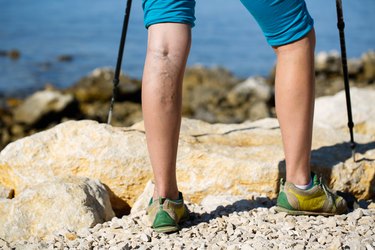
While it's not uncommon to have leg soreness after exercise, pain in your legs could indicate an issue with circulation. Sore veins in your leg after exercise can develop gradually or some on suddenly, depending on the cause.
You may feel a sharp stabbing or more of a dull ache or tingling throughout your leg or in a specific area, such as your ankle, calf or shin. There are several circulatory conditions that can cause these symptoms, each requiring different treatments.
Video of the Day
Video of the Day
Understand Blood Flow Issues
Claudication is a pain caused by too little blood flow during exercise, although as it gets worse, it can continue to cause problems even after exercise.
It's often a symptom of peripheral artery disease, as explained by Cleveland Clinic. This condition can be caused by atherosclerosis, where clumps of fat, cholesterol and other material called plaques build up inside your blood vessels.
Your doctor may prescribe medications or angioplasty, using an inflatable balloon fed through the affected vessel to widen it.
You have sheets of connective tissues under the skin in your legs that wrap around muscles, nerves and blood vessels, forming a unit known as a compartment.
If pressure builds up within these compartments, it disrupts blood flow to your muscles, causing pain — a condition called exertional compartment syndrome, as explained by the Mayo Clinic. To solve the problem, you may only need rest or a change in your exercise routine, but in extreme cases, surgery is required.
Identify Spider Veins
Spider veins, or varicose veins, are veins that become enlarged and turn blue or red and look like tree branches or twisted, bulging cords. They are caused by weak valves in your blood vessels, allowing blood to back up and pool inside the veins.
Although usually harmless, they can cause significant pain, especially during and immediately following exercise, as explained in a 2014 article published by Circulation.
To treat symptoms, you can use compression stockings. To get rid of the affected areas, however, your doctor may use sclerotherapy, where a liquid chemical is injected into the vein, surface laser treatments, radiofrequency treatments or surgery.
Beware Blood Clots
Blood clots can sometimes form in the veins in your legs, a condition called thrombophlebitis, as explained by the National Heart, Lung and Blood Institute. Sometimes the clot is close to the surface of a vein, which is superficial thrombophlebitis.
Other times it's found deep inside a vein, known as deep vein thrombosis, or DVT. Superficial thrombophlebitis usually goes away on its own and is relatively harmless.
A DVT is potentially life-threatening, as it can break out and travel through your veins to other parts of your body like your heart, lung and brain.
If you are diagnosed with DVT, your doctor will prescribe blood thinners, and you may need to wear support stockings, have a vena cava filter implanted in your abdomen, or have surgery to remove the clot.
Was this article helpful?
150 Characters Max
0/150
Thank you for sharing!
Thank you for your feedback!
Is this an emergency? If you are experiencing serious medical symptoms, please see the National Library of Medicine’s list of signs you need emergency medical attention or call 911.